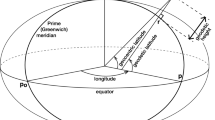Abstract
The spectrum of low-frequency sea level variations was analyzed on the basis of long-term (15–124 years) time series of sea-level data from three tide gauge stations in the Baltic Sea and two stations in the North Sea. The principal periodicities revealed in the spectrum are seasonal as well as the tidal oscillations including the pole tide with a period of about 14 months. The response function of the Baltic Sea level to variations in the North Sea level is calculated using a cross spectral analysis. It is shown that the barotropic water exchange through the Danish Straits is a basic factor in the formation of the low-frequency sea level spectrum in the Baltic Sea. The limited throughput of these straits plays the role of a natural low-pass filter for the sea level variations: high frequency sea level variations from the North Sea are effectively damped, while the low frequency signal can pass through into the Baltic Sea almost undisturbed. The simple model of the barotropic water exchange used in the study enables us to estimate the parameters of this filter. It is shown that the cutoff frequency is about 0.014 cpd (a period of 74 days): the energy of the sea level oscillations at this frequency is reduced by one half after their penetration into the Baltic Sea.
Similar content being viewed by others
References
A. K. Gusev, E. A. Zakharchuk, N. E. Ivanov, et al., Dynamics of Waters in the Baltic Sea in Synoptic Period of Spatio-Temporal Scale (Gidrometeoizdat, St. Petersburg, 2007) [in Russian].
V. G. Kort, “Large scale interaction of waters in the Northern Atlantic and atmosphere,” Okeanologiya (Moscow) 16(4), 565–570 (1976).
E. A. Kulikov and I. P. Medvedev, “Variability of the Baltic Sea level and floods in the Gulf of Finland,” Oceanology (Engl. Transl.) 53(2), 145–151 (2013).
E. A. Kulikov and I. V. Fain, “Numerical modeling of variability of the level of the Baltic Sea,” Vychislit. Tekhnol. 13(2), 39–46 (2008).
I. V. Maksimov, Geophysical Forces and Ocean Waters (Gidrometeoizdat, Leningrad, 1970) [in Russian].
I. P. Medvedev, A. B. Rabinovich, and E. A. Kulikov, “Tidal oscillations in the Baltic Sea,” Oceanology (Engl. Transl.) 53(5), 526–538 (2013).
I. P. Medvedev, A. B. Rabinovich, and E. A. Kulikov, “Pole tide in the Baltic Sea,” Oceanology (Engl. Transl.) 54(2), 121–131 (2014).
M. Carlsson, Ph. D. Thesis (Göteborg University, 1997).
G. H. Darwin, The Tides and Kindred Phenomena in the Solar System (J. Murray, London, 1898).
M. Ekman, “A common pattern for interannual and periodical sea level variations in the Baltic Sea and adjacent waters,” Geophysica, No. 32, 261–272 (1996).
B. G. Gustafsson and H. C. Andersson, “Modelling the exchange of the Baltic Sea from the meridional atmospheric pressure difference across the North Sea,” J. Geophys. Res., C: Oceans Atmos. 106(9), 19731–19744 (2001). doi: 10.1029/2000JC000593.
T. S. Jacobsen, Sea Water Exchange of the Baltic, Measurements, and Methods. Belt Project (National Agency of Environmental Protection, Denmark, 1980).
M. Johansson, H. Boman, K. K. Kahma, and J. Launiainen, “Trends in sea level variability in the Baltic Sea,” Boreal Environ. Res., No. 6, 159–179 (2001).
E. Lisitzin, Sea Level Changes (Elsevier, Amsterdam, 1974).
J. W. Miles, “Harbor Seiching,” Annu. Rev. Fluid Mech. 6, 17–35 (1974).
O. P. Nikitin, “Long-term trends of sea level in the Gulf of Finland of the Baltic Sea and movements of its shores,” in Proceedings of MWWD 2010, Ed. by C. Avanzini (MWWD Organization, 2010).
M. Samuelson and A. Stigebrandt, “Main characteristics of the long-term sea level variability in the Baltic Sea,” Tellus A 48, 672–683 (1996).
A. Stigebrandt, “Barotropic and baroclinic response of a semi-enclosed basin to barotropic forcing from the sea,” in Fjord Oceanography, Eds. by H. J. Freeland, et al. (Plenum, New York, 1980), pp. 141–164.
A. Wróblewski, “Lunar nodal tide in the Baltic Sea,” Oceanologia 43(1), 99–112 (2001).
Author information
Authors and Affiliations
Corresponding author
Additional information
Original Russian Text © E.A. Kulikov, I.P. Medvedev, K.P. Koltermann, 2015, published in Okeanologiya, 2015, Vol. 55, No. 1, pp. 5–15.
Rights and permissions
About this article
Cite this article
Kulikov, E.A., Medvedev, I.P. & Koltermann, K.P. Role of the barotropic water exchange in the formation of the Baltic Sea level spectrum. Oceanology 55, 1–10 (2015). https://doi.org/10.1134/S0001437015010117
Received:
Accepted:
Published:
Issue Date:
DOI: https://doi.org/10.1134/S0001437015010117




